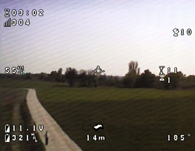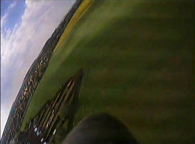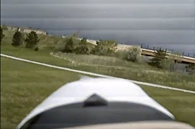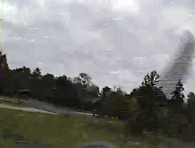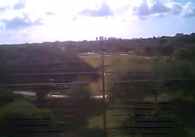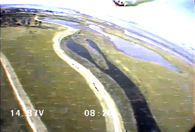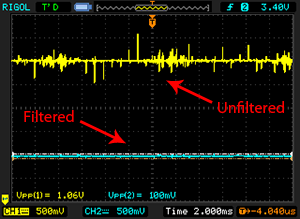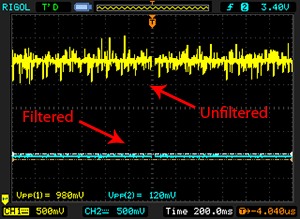- Q: What is a LC filter?
- A: It's a filter designed to suppress high-frequency radiated and conducted noise and output ideally only a DC-component. The inductor (L) is connected in serie to a capacitor (C) parallel to ground.
A crude analogy:
- A capacitor in parallel with the battery will act as a small backup battery, helping to keep the output voltage constant, reducing ripple voltage fluctuating over and under the nominal supply voltage. Filtering high frequency noise.
- An inductor in series with the battery will act as a sort of electric flywheel, once it starts spinning it can't be stopped immediately. The magnetic field generated by the current will resist change in the current flow and will release energy as needed in its attempt to maintain a constant current. Noise and ripple current will be attenuated by this effect.
- Q: What characterizes video noise?
- A: Generally it's any artifact present in the image other than the source you would get directly from the camera sensor. The images below show different scanarios and typical indications of noise. Thanks to mictronics, DrNiceGuy, VitaminJ, man2000me, airbagit13, and donnlee for the images.
- Q: Will this filter fix my problem with video interference?
- A: Short: Most likely - Long: It all depends on your current setup but this filter will significantly reduce any power supply noise before it hits the video transmitter or camera.
- Q: I'm using ferrite rings on the camera, video transmitter, and digital servo wires but still get noise, will this filter help?
- A: The ferrite rings are great for reducing some type of high frequency interference. If there's still noise it could indicate that the ferrite ring is too small to absorb the energy or there're too few windings. This filter has a common-mode choke which essentially is two copper wires coiled many times around a shared core, increasing the inductance many folds compared to a regular ferrite ring. In addition will the capacitor in this filter reduce voltage ripple (inductor reduces current ripple).
- Q: The picture quality is much better (~80%) but get some noise when both pan/tilt servos are under load. How to fix this?
- A: Digital servos can sink a lot of current, especially if the servos bind or is at the end of their range. Try to minimize the mechanical load and/or limit the travel range on the transmitter. Another idea is to use a separate BEC power supply for the receiver and servos.
- Q: After installing the filter the noise is gone but when I connect a microphone I still get noise, why?
- A: The microphone is probably located near the motor and overmodulated when it's engaged, feeding the audio-signal as overloaded noise to the video transmitter input.
Try to adjust the volume down or install an adjustable potentiometer (variable resistor) between the audio-out of the mic and audio-input of the transmitter. The potentiometer value depends on the audio-input characteristics of the transmitter, typical value would be 5K Ohm. Center tap connects to transmitter, one side (either side) to the mic output, and the last pin to transmitter ground. Adjust the volume and spin up the motor to see if it dampens the audio enough.
- Q: The noise is gone why am I still getting a wobbly image?
- A: A wobbly image would indicate vibration from the motor and usually affects CMOS-sensor based cameras. If you throttle down the motor and the wobbly effect disappears it's the motor. Try balancing the propeller to eliminate the off balance rotation and vibration. Also try to mount the camera away from the motor and use something to dampen the vibrations, e.g. velcro or soft foam between the body and camera. If that doesn't help a last resort is to swap for a CCD-sensor based camera.
- Q: What does the voltage ripple look like?
- A: Below are two images showing a DC brushed motor connected to the input of the filter running on 5V under maximum load, 1A. Yellow indicates the DC motor and blue the filtered output after the filter. The fluctuations in the yellow line illustrates the voltage ripple caused by the motor.
- Q: Why is the maximum voltage limited to 15V?
- A: Most equipment (camera, transmitter, osd) connected behind the filter are usually running on around 5V or 12V DC. On a pure 12V setup it's normal to connect a 3S Lipo battery directly to the filter and equipment, for any other type you would need to step down or boost the voltage (2S, 4S, 5S, 6S).
If you really like to have higher voltage I can install a 25V capacitor but mind that it will have a higher ESR (0.054 vs 0.012 Ohm) and less capacitance, affecting the performance a little.
- Q: What is the delivery time?
- A: It varies, but for Europe the expected delivery time is 5 to 9 days, for North America 9 to 11 days, and for Asia and Australia about 8-14 days. Packages are padded and usually shipped out the next day.
- Q: Can I pay via my credit card?
- A: Yes, indirectly by creating an account with PayPal you can use your credit card to purchase items on this site. The advantage is that your credit card details are safe and you only need to login with your PayPal credentials when checking out.
